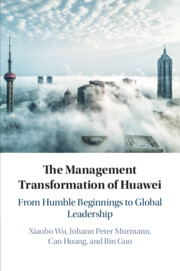Book contents
- The Management Transformation of Huawei
- The Management Transformation of Huawei
- Copyright page
- Contents
- Figures
- Tables
- Contributors
- Preface
- 1 The Management Transformation of Huawei
- 2 The Executive Management Team and Organizational Change
- 3 Transforming Product Development at Huawei
- 4 Huawei’s Transformation of Supply Chain Management
- 5 Financial Management Transformation in Huawei
- 6 The Transformation of Huawei’s HR System
- 7 Huawei’s Internationalization Journey
- 8 Huawei’s R&D Management Transformation
- 9 Huawei’s Intellectual Property Management Transformation
- 10 The Management Transformation of Huawei
- Book part
- Index
- References
4 - Huawei’s Transformation of Supply Chain Management
Published online by Cambridge University Press: 21 March 2020
- The Management Transformation of Huawei
- The Management Transformation of Huawei
- Copyright page
- Contents
- Figures
- Tables
- Contributors
- Preface
- 1 The Management Transformation of Huawei
- 2 The Executive Management Team and Organizational Change
- 3 Transforming Product Development at Huawei
- 4 Huawei’s Transformation of Supply Chain Management
- 5 Financial Management Transformation in Huawei
- 6 The Transformation of Huawei’s HR System
- 7 Huawei’s Internationalization Journey
- 8 Huawei’s R&D Management Transformation
- 9 Huawei’s Intellectual Property Management Transformation
- 10 The Management Transformation of Huawei
- Book part
- Index
- References
Summary
This chapter documents how Huawei transformed its supply chain management over the past two decades. We argue that Huawei’s supply chain management transformation can be divided into two stages: the establishment of an integrative supply chain from 1999 to 2003 and the establishment of a global supply chain from 2005 to the present. In the integrative supply chain management transformation project, IBM consultants helped Huawei identify problems in its operational processes, IT system and organizational structure. Subsequently, Huawei addressed these problems through process reengineering, an integrated IT system, and organizational change management, respectively. In the global supply chain management transformation phase, Huawei first promoted the enterprise resource planning (ERP) system in overseas subsidiaries and representative offices by tailoring the system to local laws, regulations and customer requirements and then made efforts to build an integrated global supply chain network.
Keywords
- Type
- Chapter
- Information
- The Management Transformation of HuaweiFrom Humble Beginnings to Global Leadership, pp. 136 - 170Publisher: Cambridge University PressPrint publication year: 2020



